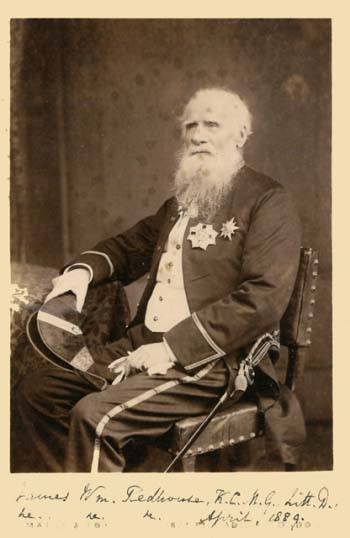
Twisting the "String" and Punishing the "Pearls"
The Editing Errors by the Historian Author Redhouse concerning the Historian Narrator Abū al-Ḥasan al-Khazrajī
Biography of Sir James William Redhouse
Redhouse was born near London on December 30, 1811 and became an orphan at any early age. He attended schools for orphans and was trained in mathematics and navigational drawing. In 1826 he was expelled for misbehavior. The young Redhouse sailed to Istanbul, where he worked as a draftsman in a shipyard, eventually becoming an instructor in one of the newly established engineering schools there. Living in Istanbul is where he learned Turkish, Arabic, Persian and French.
In time Redhouse became an official translator in the Turkish Foreign Office, where he met Mehmet Namik Pasha, who he worked together with in translating the travels of Ibn Baṭṭūṭa into Ottoman Turkish; this was presented to the Sultan Mahmut by the English King William IV (d. 1837). It was the first of many literary translations by Redhouse. He made a journey to Russia between 1830-1833 and learned Russian and the dialect spoken in eastern Anatolia. In 1834 he returned to England and taught English and French to the Ottoman ambassadors there and was married to Jane Carruthers. They both went to Istanbul, where he was a translator for the Imperial Council. He later became the private translator of the Grand Vizier Hüsrev Pasha in 1839. The sultan gave him the Ottoman Medal of Honor for his work on a mission at the siege of Acre. He spent four years in Erzurum as a translator during negotiations between the Ottomans and Persia. In Istanbul he became a member of the Imperial Academy of Arts and Sciences, established in 1850. By 1853 he returned to England, where he concentrated on translations.
Redhouse is mainly known for his lexicons. In 1842 the court published his Munakhabāt al-lugha al-‘Uthmānīya , an important dictionary of Arabic and Persian words used in Ottoman Turkish. In 1846 his Grammaire raisonee de là langue Otomane was printed in Paris, with and English translation in 1884. In 1856 his English and Turkish Dictionary was published in London with several later editions. Because Protestant missionaries found this useful for their conversion work in Ottoman territory, it was at one point banned by the Ottomans. In 1950 a revised edition of Redhouse’s dictionary was published in Latin letters. It seems that Redhouse planned a ten-volume dictionary of Ottoman Turkish, indicating pronunciation and etymology, sending much of this to Istanbul in 1885. This apparently has been lost.
There are actually quite a few translations made by Redhouse. Online one can find the following:
The Diary of H.M. the Shah of Persia, during his Tour through Europe in A.D. 1873. London, Murray, 1874.
A Vindication of the Ottoman Sultan's Title of "Caliph". London: Effingham Wilson, Royal Exchange, 1877.
On the History, System, and Varieties of Turkish Poetry. London: Trübner and Co., 1879.
The Mesnevî of Rūmī. London: Trübner and Co., 1881.
Legends of the Sufis. Wheaton: The Theosophical Publishing House, 1976/1881.
The self-trained Orientalist who had no academic training as a scholar received an honorary doctorate from the University of Cambridge in 1884 and was knighted in 1888, quite an achievement for an orphan who served the Ottoman Empire. He died January 4, 1892.
For a biography of Redhouse, see Carter V. Findley, “Sir James W. Redhouse (1811-1892): The Making of a Perfect Orientalist?” Journal of the American Oriental Society 99(4):573-600, 1979. For a short biography in Turkish, click here. In May, 2017 a conference was held at Haceteppe University in Turkey on the life and work of Redhouse
There is still no major biography of this very important Orientalist.
This page was created and is maintained by the webshaykh Daniel Martin Varisco


